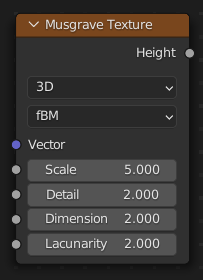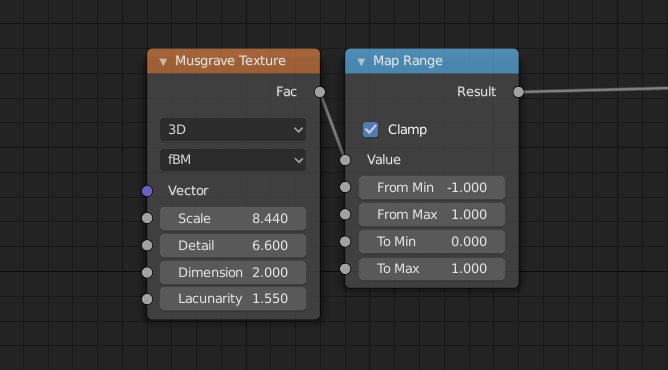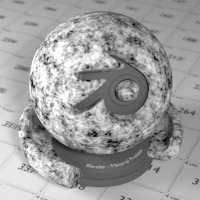Musgrave Texture Node

The Musgrave Texture node evaluates a fractal Perlin noise at the input texture coordinates. Unlike the Noise Texture, which is also a fractal Perlin noise, the Musgrave Texture allows greater control over how octaves are combined.
Inputs
The inputs are dynamic, they become available if needed depending on the node properties.
- Vector
Texture coordinate to evaluate the noise at; defaults to Generated texture coordinates if the socket is left unconnected.
- W
Texture coordinate to evaluate the noise at.
- Scale
Scale of the base noise octave.
- Detail
Number of noise octaves. The fractional part of the input is multiplied by the magnitude of the highest octave. Higher number of octaves corresponds to a higher render time.
- Dimension
The difference between the magnitude of each two consecutive octaves. Larger values corresponds to smaller magnitudes for higher octaves.
- Lacunarity
The difference between the scale of each two consecutive octaves. Larger values corresponds to larger scale for higher octaves.
- Offset
An added offset to each octave, determines the level where the highest octave will appear.
- Gain
An extra multiplier to tune the magnitude of octaves.
Properties
- Dimensions
The dimensions of the space to evaluate the noise in.
- 1D
Evaluate the noise in 1D space at the input W.
- 2D
Evaluate the noise in 2D space at the input Vector. The Z component is ignored.
- 3D
Evaluate the noise in 3D space at the input Vector.
- 4D
Evaluate the noise in 4D space at the input Vector and the input W as the fourth dimension.
Higher dimensions corresponds to higher render time, so lower dimensions should be used unless higher dimensions are necessary.
- Type
Type of the Musgrave texture.
- FBM (Fractal Brownian Motion)
Produces an unnatural homogeneous and isotropic result. Uses an additive cascade, the values are simply added together.
- Multifractal
The result is more uneven (varies with location), more similar to a real terrain. Uses a multiplicative cascade.
- Hybrid Multifractal
Creates peaks and valleys with different roughness values, like real mountains rise out of flat plains. Combines the additive cascade with a multiplicative cascade.
- Ridged Multifractal
Creates sharp peaks. Calculates the absolute value of the noise, creating „canyons“, and then flips the surface upside down.
- Hetero Terrain (Heterogeneous Terrain)
Similar to Hybrid Multifractal creates a heterogeneous terrain, but with the likeness of river channels.
Outputs
- Height
Texture value.
Primeri

Nodes for the image to the right. |

Musgrave texture. |
Musgrave Types

fBM (fractal Brownian Motion). |

Multifractal. |

Hybrid Multifractal. |

Heterogeneous Terrain. |

Ridged Multifractal. |
Poglej Tudi